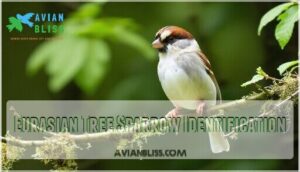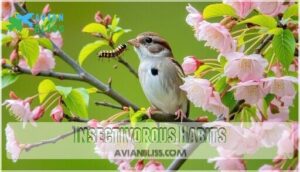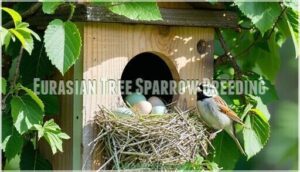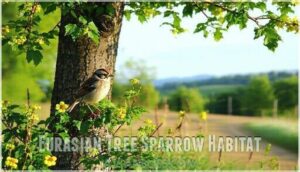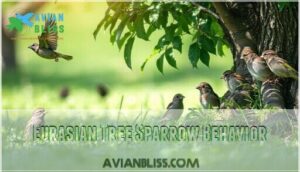This site is supported by our readers. We may earn a commission, at no cost to you, if you purchase through links.
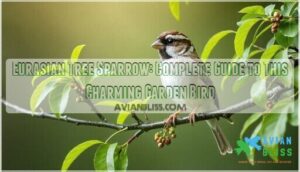 You’ll recognize the eurasian tree sparrow by its signature chestnut cap and distinctive black cheek patch on white cheeks—markings that both males and females share year-round.
You’ll recognize the eurasian tree sparrow by its signature chestnut cap and distinctive black cheek patch on white cheeks—markings that both males and females share year-round.
This compact, five-inch bird belongs to the Old World sparrow family and thrives across Europe, Asia, and parts of North America, particularly Missouri and Illinois.
Unlike its house sparrow cousin, it prefers woodland edges and agricultural areas where it forages for seeds like chickweed and goosefoot.
During breeding season, it switches gears to hunt insects, feeding caterpillars and beetles to its young in cavity nests.
These adaptable little seed-crackers raise multiple broods annually, showcasing remarkable resilience that’s helped them colonize diverse landscapes from European farms to suburban backyards.
Table Of Contents
- Key Takeaways
- Eurasian Tree Sparrow Overview
- Eurasian Tree Sparrow Identification
- Eurasian Tree Sparrow Diet
- Eurasian Tree Sparrow Breeding
- Eurasian Tree Sparrow Habitat
- Eurasian Tree Sparrow Conservation
- Eurasian Tree Sparrow Behavior
- Frequently Asked Questions (FAQs)
- What is the difference between a house sparrow and a Eurasian tree sparrow?
- What is an Eurasian tree sparrow?
- Where did Eurasian sparrows come from?
- What is the difference between a House Sparrow and an Eurasian tree sparrow?
- How to take care of Eurasian tree sparrows?
- Are Eurasian Tree Sparrows rare?
- What is the difference between a House Sparrow and a Eurasian tree sparrow?
- Where do Eurasian Tree Sparrows live?
- What is another name for the Eurasian tree sparrow?
- How do Eurasian Tree Sparrows communicate with each other?
- Conclusion
Key Takeaways
- You’ll identify Eurasian Tree Sparrows by their distinctive chestnut cap and black cheek patches on white cheeks—markings that remain consistent year-round for both males and females.
- You can find these adaptable birds in semi-open landscapes like woodland edges and agricultural areas across Europe, Asia, and parts of Missouri and Illinois, where they prefer countryside over dense urban environments.
- You’ll observe their seasonal diet switching from seeds (chickweed, goosefoot, agricultural grains) during most of the year to protein-rich insects when feeding their young in cavity nests.
- You’ll notice their remarkable breeding success stems from raising 2-3 broods annually in tree cavities or nest boxes, with both parents sharing incubation and feeding duties for 15-18 days until fledging.
Eurasian Tree Sparrow Overview
You’ll recognize this small songbird by its distinctive chestnut cap and black cheek patches on white cheeks, making it quite different from the common House Sparrow.
The Eurasian Tree Sparrow (Passer montanus) belongs to the Old World Sparrows family and has established a modest population in parts of Missouri, Illinois, and Iowa since its 1870 introduction, which is a notable introduction.
Scientific Classification
When examining Taxonomy Systems and Species Identification, you’ll find the Eurasian Tree Sparrow (Passer montanus) belongs to the order Passeriformes—that’s the perching birds club where most songbirds hang out.
Within Bird Orders and Family Classification, it’s part of Passeridae, the Old World Sparrows family.
Genetic Analysis confirms this small songbird’s place among true sparrows, distinguishing it from New World species that simply borrowed the name.
Physical Description
You’ll recognize this chestnut-capped beauty by its distinctive plumage patterns and compact body size.
The Eurasian Tree Sparrow’s physical characteristics include striking white-cheeked facial markings contrasted against dark ear patches.
Its beak shape remains sturdy yet refined, perfect for seed-cracking.
Feather colors blend warm browns across the crown with lighter underparts, and the wing structure displays subtle white bars over brown streaking.
Males and females share identical plumage year-round, unlike many songbirds.
Habitat and Distribution
You’ll find the Eurasian tree sparrow’s geographic range spans Europe, Asia, and parts of Africa, with North American populations concentrated in Missouri, Illinois, and southeastern Iowa.
These urban birds adapt well to diverse bird habitats, from rural farms to suburban parks.
Their habitat preferences include semi-open woodland edges and agricultural areas. While some populations show migration patterns moving southward in winter, habitat loss from urban expansion continues challenging their ecological niche.
Eurasian Tree Sparrow Identification
You’ll easily recognize a Eurasian Tree Sparrow by its distinctive chestnut crown and black cheek spot on white cheeks—features that set it apart from its more common House Sparrow cousin.
These small songbirds measure just 5-5.5 inches long and weigh less than an ounce, making proper identification essential for backyard birdwatchers.
Distinctive Features
You’ll spot this chestnut-capped beauty by its signature features that set it apart from backyard regulars.
The Eurasian Tree Sparrow’s distinctive chestnut cap crowns its head like a russet beret, while pure white cheeks showcase bold black ear spots that look like nature’s beauty marks.
Key identifying features include:
- Chestnut cap and nape – Rich brown coloring that stays consistent year-round
- Black cheek patch – Kidney-shaped ear spots on bright white cheeks
- Narrow white bars – Two thin stripes across brown, streaked wings
The beak color shifts seasonally from lead-blue in summer to nearly black in winter, helping you pinpoint the time of year.
The Eurasian Tree Sparrow’s breeding habits are influenced by factors such as nest box material that affect its reproductive success.
Comparison to House Sparrow
You’ll notice the eurasian tree sparrow differs substantially from the house sparrow in several key ways.
While both species share similar sparrow size, their feather color patterns tell different stories.
House sparrows sport grey caps and lack distinctive cheek spots, whereas eurasian tree sparrows showcase chestnut crowns with bold black patches on white cheeks.
Their beak shape remains similar, but competition between these species affects their nesting style preferences and migration patterns, creating important ecological impact considerations for bird conservation efforts.
Similar Species
Several bird species share similar features with Eurasian Tree Sparrows, creating identification challenges for birdwatchers.
Chipping sparrows display rusty caps and black eye lines but lack the distinctive white cheek patches. House sparrows show grey caps without cheek spots and possess more robust bodies.
These sparrow lookalikes demonstrate fascinating bird mimicry patterns among passerine birds. Understanding species comparison helps distinguish between sparrow hybrids and true avian relatives within this diverse sparrow birds family.
Eurasian Tree Sparrow Diet
You’ll find that Eurasian Tree Sparrows have quite the varied appetite, switching between seeds and insects depending on the season and their breeding needs.
These feathered foodies become master multitaskers, expertly balancing their seed-cracking skills with insect-hunting prowess throughout the seasons
Their feeding habits reveal fascinating strategies that help them compete with other birds while raising healthy broods, which is a key aspect of their breeding needs.
Seed Consumption
You’ll find eurasian tree sparrows have distinct grain preferences that shape their feeding habits.
These birds consume chickweed and goosefoot seeds regularly, plus agricultural grains like oats, wheat, corn, and sunflower seeds.
Their dietary adaptation includes weed seed consumption from grasses and various plants, and foraging strategies involve ground-feeding in flocks, often mixing with finches and buntings.
Bird diet studies show they’re selective seed consumers, making smart choices about available food sources, such as those found in a typical bird seed mix, which can substantially influence the local bird population’s feeding habits.
Insectivorous Habits
While seeds form their foundation diet, you’ll discover these birds transform into skilled insectivores during breeding season.
Insect prey comprises up to 88% of their food intake when feeding nestlings. Their foraging tactics target caterpillars, beetles, spiders, and mites across multiple levels – ground, grass, bushes, and lower branches.
This protein-rich bug consumption guarantees proper chick development, while their insect predation provides valuable pest control in gardens and farms.
The Eurasian Tree Sparrow’s diet is also influenced by cherry blossom ecology and the availability of nectar in their habitat.
Feeding Strategies
You’ll discover that Eurasian Tree Sparrows employ two distinct foraging tactics regarding seed selection and bird feeding.
These clever birds act as both "producers" and "scroungers" – some actively search for food while others cleverly follow successful finders. Their flock behavior creates safety in numbers during foraging expeditions.
When visiting feeders, they show clear feeder preferences for platform-style setups offering diverse options.
Their adaptable diet means they’ll switch between seed consumption and insect consumption based on seasonal availability and nutritional needs, allowing them to be successful scroungers.
Eurasian Tree Sparrow Breeding
If you’re lucky enough to spot Eurasian Tree Sparrows in your area, you’ll witness one of nature’s most dedicated parenting teams in action.
These charming birds typically breed from April through August, with pairs working together to raise two to three broods each season in cozy tree cavities or nest boxes.
They are raising their young in cozy environments, which are essential for their survival.
Nesting Habits
You’ll find Eurasian Tree Sparrows are cavity nesting specialists who prefer tree holes, building crevices, or nest boxes for their breeding seasons.
These adaptable birds construct messy cup-shaped nests using hay, grass, and straw, then line them with feathers and soft materials.
Males typically choose nesting sites to attract mates, though both sexes participate in nest construction.
Their sparrow habitat preferences include semi-open areas with scattered trees, making bird nesting opportunities abundant in suburban gardens and lightly wooded countryside.
The Eurasian Tree Sparrow’s nesting success is influenced by factors related to nest site selection, which is essential for their survival and reproduction.
Egg Laying and Incubation
Once you’ve got your Eurasian Tree Sparrow nest construction sorted, the real action begins with egg formation.
Your birds typically lay 4-6 eggs from April to August, with each clutch containing white to pale gray eggs marked with brown speckling.
The incubation period lasts 12-13 days, with both parents sharing duties.
They’ll start incubating after the second-to-last egg arrives, ensuring synchronized hatching.
This brood size gives them flexibility for raising multiple broods each season.
Fledgling and Parental Care
Young eurasian tree sparrow chicks fledge after fifteen to eighteen days in the nestling period.
These dedicated parents take just over two weeks to transform helpless nestlings into flight-ready fledglings
These dedicated parents take just over two weeks to transform helpless nestlings into flight-ready fledglings.
You’ll notice parents continue feeding these fledglings for another week after they leave the nest.
During chick development stages, both parents work tirelessly during the fledgling stage, bringing insects every few minutes.
This dedicated parental care guarantees strong brood survival rates throughout the critical fledging period.
Eurasian Tree Sparrow Habitat
You’ll find Eurasian Tree Sparrows thriving in semi-open landscapes where scattered trees meet open spaces, from farm edges to suburban parks with plenty of bushes.
Unlike their city-loving House Sparrow cousins, these birds prefer the countryside life, avoiding dense urban centers.
While some populations migrate south for winter warmth, they generally stick to their preferred countryside environments.
Preferred Environments
You’ll discover these adaptable birds thriving in woodland edges and farm habitats across their range.
They favor semi-open landscapes that blend trees with clearings, making suburban areas and rural landscapes ideal homes.
Look for them in hedgerows, bushy parks, and residential areas where scattered vegetation provides cover.
Unlike dense forests, they prefer farms and rural habitats offering mixed environments with feeding opportunities and nesting sites nearby.
The presence of garden birdhouses can substantially enhance the bird nesting sites in these areas, providing a suitable location for bird nesting.
Urban and Rural Settings
You’ll notice eurasian tree sparrows adapt differently to urban environments versus rural areas.
While they thrive on farms and in agricultural settings, Urban Expansion has pushed these birds away from dense city centers.
Rural Adaptation remains their strength, as habitat fragmentation affects their urban success.
Human Impact creates challenges through Environmental Effects, but habitat restoration efforts in suburban zones offer promising middle ground between bustling cities and open farmland.
The installation of bird bath systems can help support local bird populations in these areas, leveraging Rural Adaptation for better outcomes.
Migration Patterns
You’ll discover that most Eurasian tree sparrows stick around year-round, breaking the mold of typical bird migration patterns.
Unlike their house sparrow cousins, these hardy birds rarely venture far from home.
Here’s what drives their seasonal movements:
- Northern populations make short southward trips during harsh winters
- Temperate regions maintain resident populations with minimal habitat shifts
- Bird tracking studies show only 10-20% of northern birds actually migrate
- Migration routes remain local, rarely crossing country boundaries
- Wintering grounds overlap substantially with breeding territories
Their sedentary lifestyle reflects stable food sources and adaptable nature.
Eurasian Tree Sparrow Conservation
The Eurasian Tree Sparrow’s conservation story in North America is surprisingly different from many introduced species—their limited spread has actually helped them coexist peacefully with native birds.
You’ll find that climate change might push these adaptable sparrows northward, potentially expanding their range beyond their current Missouri-Illinois-Iowa stronghold, which could lead to a significant shift in their conservation status.
Impact on Native Species
Competition for nesting cavities creates real challenges for native birds when Eurasian tree sparrows arrive.
These invasive species often claim prime real estate before local cavity-nesters can establish territories.
The ecological impact varies by region, but Species Competition intensifies during breeding season when suitable sites become scarce.
| Impact Type | Native Species Affected | Severity Level |
|---|---|---|
| Cavity Competition | Bluebirds, Tree Swallows | Moderate |
| Food Resource Overlap | Small Passerines | Low-Moderate |
| Habitat Displacement | Woodpeckers, Chickadees | Variable |
| Biodiversity Impact | Ground-foraging Birds | Regional |
The presence of Eurasian tree sparrows leads to Cavity Competition, Food Resource Overlap, Habitat Displacement, and Biodiversity Impact, all of which affect native bird species in different ways, with varying Severity Level.
Competition With House Sparrows
You’ll find that house sparrow competition substantially shaped eurasian tree sparrow establishment in North America.
When both species arrived simultaneously in St. Louis, house sparrows dominated urban areas, forcing tree sparrows into specific niches.
This territorial defense created distinct coexistence strategies:
- Nesting Competition – Tree sparrows chose natural cavities while house sparrows claimed buildings
- Resource Rivalry – Different foraging areas reduced direct competition
- Habitat Restoration – Niche partitioning allowed both species survival
These sparrow interactions demonstrate successful adaptation despite initial rivalry.
Climate Change Effects
Climate change creates a perfect storm of challenges for these sparrows.
Temperature shifts push their range northward, while altered weather patterns disrupt traditional migration trends.
Warming temperatures may benefit some populations through earlier breeding, but ecosystem disruption threatens food sources.
You’ll see these birds adapting to new climate threats through physiological changes.
Understanding the climate change impacts is essential for developing effective conservation strategies.
| Climate Impact | Effect on Sparrows | Conservation Response |
|---|---|---|
| Temperature Shift | Northward range expansion | Monitor new habitats |
| Weather Patterns | Breeding timing changes | Habitat protection |
| Sea Level Rise | Coastal habitat loss | Inland corridors |
Eurasian Tree Sparrow Behavior
You’ll discover that Eurasian Tree Sparrows are surprisingly social creatures that form tight-knit flocks throughout most of the year.
Their foraging behavior involves both cooperative feeding strategies and occasional territorial disputes, making them fascinating subjects for backyard bird watching.
Social Interactions
You’ll observe Eurasian Tree Sparrows gathering in small bird flocks throughout the year, creating dynamic social interactions that fascinate birdwatchers.
These clever birds establish dominance hierarchies within their groups, with older individuals typically leading younger ones during group foraging expeditions.
Their communication patterns include distinctive chirps and calls that coordinate flock movements and signal potential threats, which is an example of social learning when inexperienced birds watch established members locate food sources.
During breeding season, mate selection involves elaborate courtship displays, while bird aggression surfaces during territorial disputes over prime nesting sites.
Foraging Habits
You’ll often spot eurasian tree sparrows employing smart foraging strategies while searching for food sources.
These adaptable birds demonstrate remarkable dietary adaptation through varied seed selection, switching between ground-level foraging behavior and aerial hunting.
Their feeding behavior includes both "producer" tactics—actively searching for seeds—and "scrounger" methods, following other birds to discovered food patches.
During summer months, their bird foraging shifts toward protein-rich insects for breeding needs, showcasing flexible diet management that’s helped them thrive across diverse environments.
The eurasian tree sparrow’s ability to adapt to different bird habitat distributions is a key factor in their success as a species, utilizing effective foraging behavior.
Aggressive Behavior
While you’ll notice their peaceful foraging habits, Eurasian Tree Sparrows show surprising fierce behavior during breeding season.
These birds establish clear dominance hierarchy through aggressive interactions and territorial fights.
You’ll witness threat displays like wing-fanning when sparrows compete for nest boxes, often evicting native species through persistent agonistic interactions.
Their competitive foraging creates intense bird aggressive interactions, with dominant individuals controlling prime feeding spots through aggressive species comparison tactics, which involves aggressive interactions.
Frequently Asked Questions (FAQs)
What is the difference between a house sparrow and a Eurasian tree sparrow?
Think of these sparrows as twin cousins with different fashion choices—you’ll spot the key differences right away.
House sparrows sport gray caps and lack cheek spots, while Eurasian tree sparrows wear chestnut crowns with distinctive black patches on white cheeks.
What is an Eurasian tree sparrow?
You’ll recognize this small songbird by its distinctive chestnut cap and black cheek patch on white cheeks.
It’s a Eurasian species that’s established itself in parts of Missouri, Illinois, and Iowa since
Where did Eurasian sparrows come from?
You’ll discover that Eurasian Tree Sparrows originated in Europe and Asia, where they’ve thrived for centuries.
German immigrants brought twelve birds to St. Louis, Missouri in 1870, establishing North America’s only population of Eurasian Tree Sparrows.
What is the difference between a House Sparrow and an Eurasian tree sparrow?
You’ll spot the difference in their "caps" – House Sparrows wear gray crowns while Eurasian Tree Sparrows sport chestnut ones.
Tree Sparrows also have distinctive black ear patches on white cheeks, unlike House Sparrows’ plainer faces, which is a key difference to note the distinctive features.
How to take care of Eurasian tree sparrows?
You can’t domestically care for wild Eurasian tree sparrows—they’re protected wildlife requiring specific permits.
Instead, support them by providing platform feeders with mixed seeds, fresh water sources, and nesting boxes in your yard.
Are Eurasian Tree Sparrows rare?
With only 150,000 birds estimated in 1987, you’d find these chestnut-capped songbirds aren’t exactly common across North America.
They’re regionally abundant in Missouri, Illinois, and Iowa but rare elsewhere since their introduction failed to spread widely like House Sparrows.
What is the difference between a House Sparrow and a Eurasian tree sparrow?
You’ll notice House Sparrows have gray caps and lack cheek spots.
While Eurasian Tree Sparrows sport distinctive chestnut crowns and black ear patches on white cheeks—it’s like comparing cousins with different fashion sense.
Where do Eurasian Tree Sparrows live?
Funnily enough, you’ll find these adaptable birds thriving where farms meet forests.
They prefer open countryside with scattered trees and bushes across Missouri, Illinois, and southeastern Iowa—avoiding dense cities unlike their European cousins, and they are found in areas with scattered trees and bushes.
What is another name for the Eurasian tree sparrow?
You’ll find this small songbird goes by several names, including its scientific designation Passer montanus.
Most commonly, it’s simply called the Tree Sparrow in many regions outside North America, where it’s distinguished from the House Sparrow.
How do Eurasian Tree Sparrows communicate with each other?
Like tiny feathered messengers in nature’s network, you’ll hear these birds share their world through varied chirps, calls, and chattering.
They use contact calls to stay connected while foraging, alarm calls when danger threatens, and soft conversational notes during social interactions with their flock.
Conclusion
Understanding the eurasian tree sparrow’s adaptability reveals nature’s remarkable problem-solving abilities.
You’ll find these resilient birds thriving wherever they can access seeds and suitable nesting sites.
Their success stems from flexible feeding habits—switching between seeds and insects seasonally—and their willingness to coexist with humans.
Whether you’re spotting them in European farmland or North American suburbs, eurasian tree sparrows demonstrate how species can flourish through behavioral flexibility and ecological opportunism.

